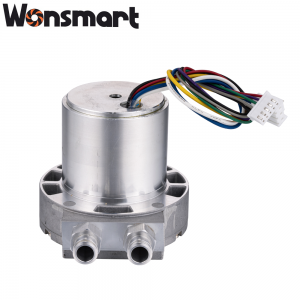The Role of Brushless DC Air Blowers in Dryers
1. Core Functions
The brushless DC air blower plays a critical role in dryers, with its primary function being to facilitate airflow, thereby optimizing drying efficiency. Its key contributions include:
(1) Air Circulation
The blower ensures uniform air distribution within the dryer through forced convection, preventing localized overheating or uneven drying, thus guaranteeing consistent material heating.
(2) Heat Transfer
It rapidly delivers heat generated by heating elements to the drying zone, improving thermal efficiency, reducing drying time, and lowering energy consumption.
(3) Moisture Evacuation
By accelerating the removal of humid air, the blower prevents moisture from re-condensing on the material surface, enhancing drying performance.
2. Selection of Brushless DC Air Blower Types
The choice of blower type is crucial depending on drying requirements. Common options include:
- Centrifugal Blowers: Suitable for high-airflow, medium-to-high-pressure drying systems, such as food or industrial drying equipment.
 |
 |
 |
|
| Model | WS4540-12-NZ03 | WS7040-12-X200 | WS7040AL-12-X200 |
| Voltage | 12VDC | 12VDC | 12VDC |
| Max. Airflow | 7.2 m³/h | 25 m³/h | 19 m³/h |
| Max. Pressure | 5 kPa | 6 kPa | 5.5 kPa |
| Current Level | 0.9–1.65 A | 1.5–4.5 A | 2.4–4.5 A |
| Speed Level | 45,000–49,000 rpm | 35,000–43,000 rpm | 34,000–42,500 rpm |
| Noise Level | 48–65 dB(A) | 50–73 dB(A) | 56–68 dB(A) |
- Axial Blowers: Ideal for high-resistance, low-airflow applications, such as hand dryers or small-scale drying systems.
 |
|
| Model | WS9070-24-S200 |
| Voltage | 24VDC |
| Max. Airflow | 7.2 m³/h (120 L/min) |
| Max. Pressure | 15 kPa |
| Current Level | 1.7–3 A |
| Speed Level | 26,500–28,500 rpm |
| Noise Level | 47–72 dB(A) |
- High-Pressure Blowers: Used in high-resistance systems, such as high-temperature drying or long duct configurations.
| Image |  |
 |
|---|---|---|
| Model | WS145110-48-150-X300 | WS145120-48-170-S200 |
| Voltage | 48VDC | 48VDC |
| Max. Airflow | 33 m³/h | 92 m³/h |
| Max. Pressure | 32 kPa | 40 kPa |
| Current Level | 3–8.8 A | 6.5–29 A |
| Speed Level | 13,000–15,000 rpm | 15,200–17,500 rpm |
| Noise Level | 69–90 dB(A) | 69–92 dB(A) |
The optimal selection depends on factors like airflow, pressure, temperature, and medium characteristics.
3. Key Performance Requirements
(1) Airflow (m³/h)
Airflow directly impacts drying efficiency. The required airflow should be calculated based on material moisture content and volume to ensure sufficient air exchange.
(2) High-Temperature Resistance
Since dryers operate at elevated temperatures, the blower must be constructed from heat-resistant materials (e.g., aluminum alloy, stainless steel, or specialized coatings) for long-term reliability.
(3) System Resistance (Pa)
The blower must overcome system resistance, including ductwork and filters, to maintain smooth airflow.
(4) Medium Compatibility
If the drying medium contains dust or corrosive gases, the blower should feature dustproof and corrosion-resistant designs, such as added filtration or stainless steel construction.
4. Practical Applications
(1) Hand Dryers
Utilize low-noise axial blowers to deliver high-speed airflow, accelerating moisture evaporation for efficient drying.
(2) Food Drying
In vegetable or fruit dryers, heat-resistant centrifugal blowers ensure even heat distribution, preventing scorching and improving drying quality.
(3) Industrial Drying
For wood or textile drying, high-pressure blowers are employed to manage high-resistance systems and achieve deep drying.
5. Common Issues & Solutions
| Issue | Possible Cause | Solution |
| Low drying efficiency | Insufficient airflow | Increase blower capacity or upgrade to a higher-flow model |
| Uneven temperature distribution | Poor airflow uniformity | Optimize duct design or switch to a centrifugal blower |
| Blower overheating | Inadequate heat resistance | Upgrade to a high-temperature model or improve cooling |
| Excessive noise | Worn bearings or high RPM | Inspect bearings or switch to a low-noise blower |
6. Customization Services
We offer custom brushless DC air blowers for dryers, tailored to your specific needs. For optimal performance, please provide the following parameters:
✅ Drying Temperature (°C)
✅ Airflow Requirement (m³/h)
✅ System Resistance (Pa)
✅ Medium Characteristics (presence of dust/corrosive gases)
By precisely matching blower specifications, drying efficiency can be significantly improved while reducing energy consumption and extending equipment lifespan. Contact us for further consultation!
Conclusion: The brushless DC air blower enhances dryer performance by optimizing airflow, heat transfer, and moisture removal. Selecting the right blower type and ensuring key parameters such as airflow and temperature resistance are met can drastically improve drying outcomes. For custom solutions, provide detailed specifications, and we will deliver the optimal blower configuration.
Post time: Apr-10-2025

